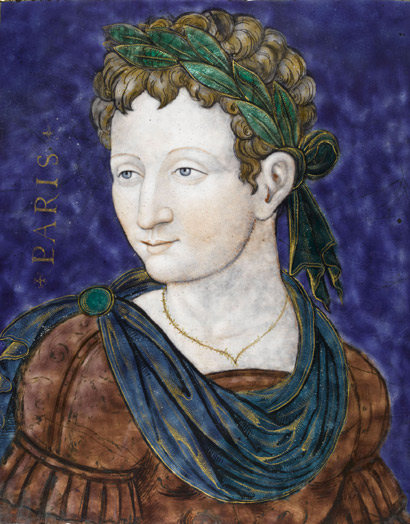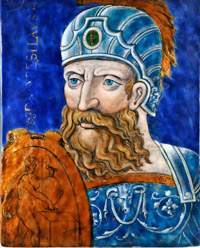
Paris Léonard Limosin (ca. 1505 - ca.1577) Ca. 1564
Enamel on copper, gold letters H. 31.5 cm x L. 25.7cm Ecouen, musée national de la Renaissance (c) RMN / Stéphane Maréchalle |
|
MUSÉE NATIONAL DE LA RENAISSANCE
Château d’Écouen - 95440 ÉCOUEN
INFORMATION:
• Tel: 0033 1 34 38 38 50
• www.musee-renaissance.fr
OPENING HOURS:
Open every day except Tuesday, from 9: 30 to 12: 45 AM and from 2:00 to 5: 15 PM.
ADMISSION PRICE:
• Full rate: 4.50 €
• Reduced rate: 3 €
• Group rate: 4 € (as of 10 persons)
• Free for visitors under the age of 26 and for everyone on the first Sunday of the month.
These rates include the exhibition and the permanent collections.
CURATORSHIP:
• Thierry Crépin-Leblond, director of the museum
• Stéphanie Deprouw, assistant curator at the musée national de la Renaissance
PRESS CONTACT:
Michaël Caucat
• Tel : 0033 1 34 38 38 64
• michael.caucat@culture.gouv.fr

|
Following the recent acquisition of a painted enamel representing Paris, at the sale of the Yves Saint Laurent / Pierre Bergé collection, the Musée national de la Renaissance presents the series of portraits of heroes of Antiquity imagined by Léonard Limosin inspired by Ovid’s poem The Heroides. Some sixty works, drawings, illuminated manuscripts and painted enamels shed a new light on this exceptional decorative program.
The love affairs of the heroes of Antiquity
This series of enamels from the 1560s by Léonard Limosin (ca 1505-ca 1577), enameller to king Henry II was inserted under the panelling of a studiolo or «cabinet des émaux», similar to that of Catherine de' Medici at the hôtel de Soissons. These enamels are inspired directly from Ovid’s poem, known as the Heroides. Through the bias of imaginary letters the poem tells the tragic love affairs of heroes and heroines of Antiquity. A French translation by a bishop from the entourage of Louise de Savoie, mother of king Francis I of France, sparked up the interest in the poem on the eve of the Renaissance. Standing next to various printed editions that prove how widely the text was diffused throughout the 16th century, the exhibition presents a large choice of manuscripts that unveil the fashion for that poem at the court of the Valois. The copy that belonged to Louise de Savoie, illuminated by painter Jean Pichore and lent by the Bibliothèque nationale de France, is one of the most beautiful examples of this popularity.
A decorative unicum
Aside from the arts of the book, Ovid’s lovers were only presented once in the decorative arts: therefore Léonard Limosin’s is a unicum, a commission from an amateur particularly sensitive to the text. Following the taste of the Renaissance for effigies of heroes of Antiquity, Léonard Limosin treated the Ovidian theme as portraits. Hercules and Dejanira, Jason and Medea, Ariadne and Theseus, Phaedra and Hippolytus, Protesilaus, Paris, Briseis or Orestes, are all painted as busts, three-quarters or fullface and identified by their names written in gold letters, on a background in intense blue, typical of the artist’s famous portraits.
 Illustration: Protesilaus Léonard Limosin (ca.1505 - ca.1577). Ca. 1564 Enamel on copper, gold lettering
H. 30.6 cm x L. 24.6 cm Compiègne, musée Vivenel (c) Musée Antoine Vivenel, Compiègne / photo Christian Schryve
It seems that in order to embody his heroes, Léonard Limosin drew those amazing faces himself. Sometimes he would draw his inspiration from portraits in pencil after Clouet. For instance, he used the features of Anne d’Este, duchess of Guise, to represent the enchantress Medea. The culminating point of the exhibition is the reconstitution of this cycle of the Heroides, together for the first time thanks to loans from the Vivenel museum in Compiègne, the Crozatier museum in Le Puy-en-Velay and the musée des Beaux-Arts in Blois. Consequently, out of the seventeen identified plates, twelve are presented in the literary and artistic atmosphere of their creation, next to other works by Léonard Limosin. This is a rare occasion to discover a remarkable artist of the French Renaissance.
PUBLICATION:
De la lettre à l’émail. Léonard Limosin interprète Ovide, by Thierry Crépin-Leblond and Stéphanie Deprouw. 17 x 19. 5 cm, 56 pages, 19 colored illustrations, Rmn Éditions, paperback edition, 7 €. Published in March 2010.
Buy this catalog at Fnac
|









